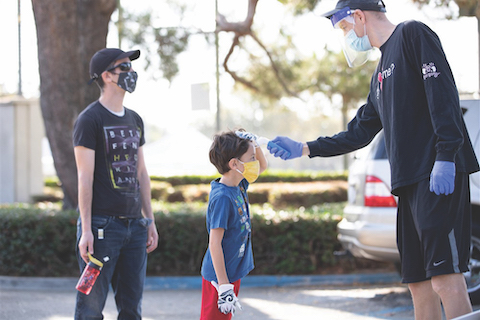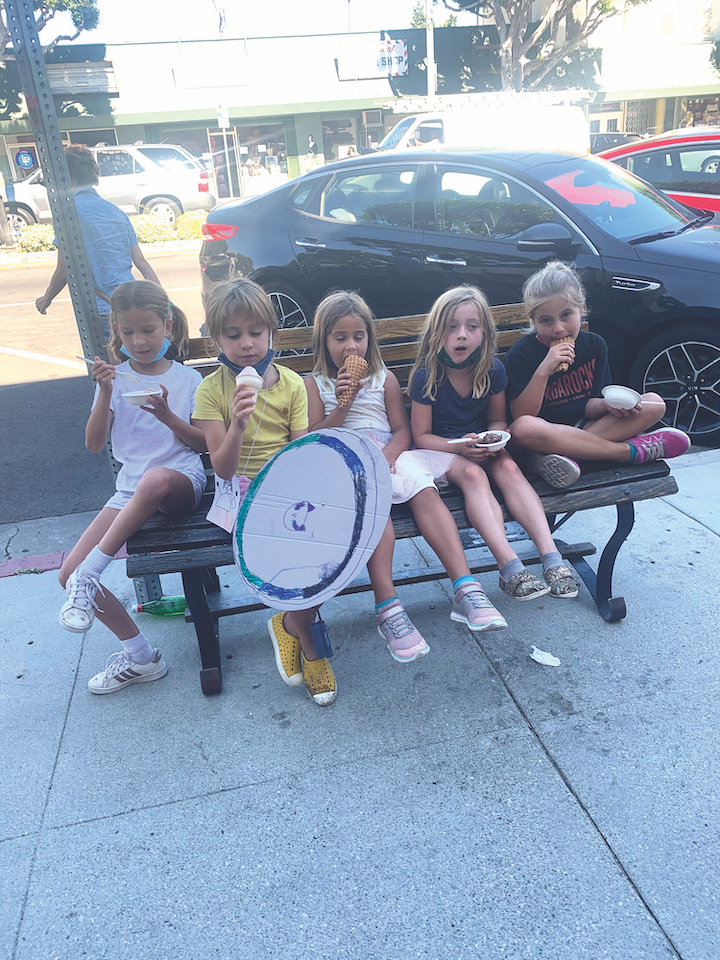
HEAD COACH Korey Kalman, founder of Got Game, administers a temperature check for a pod participant at La Cienega Park July 27.
Virtual school started for students across the county as of the printing of this issue. While the construct of this is uniform, the experience of it certainly won’t be. Pods, “podding” or “pod learning” offer an opportunity for some children to do their virtual learning together. But is it a viable solution for everyone? My exploration into this area reveals it can be a challenge to organize, but has the potential to provide help for families and much needed socialization for children.
Types of pods
In my search (personal) and research (professional), I have learned quite a bit about pods in the last month and half. It’s a lot to mull over. There are many different types of pods, it turns out. The most basic example of this is whether a family wants a learning pod or an activity pod, or both.
A learning pod entails a group of about four to six kids who will be in the same physical location while they attend “online school.” This could be in a garage or an on-property guest house or in a shady backyard. Depending on the risk tolerance of the participants, it could conceivably be at a large dining room table. At any rate, the idea is that the students will benefit by learning alongside their peers.

RECREATIONAL PLAY pod members: Nikka Gueler, Blythe Pons, Keller Alling, Anna Paley and Lydia Alling.
An activity pod fulfills the social and emotional needs of children after virtual school hours. It provides an opportunity for children to get together for supervised play. A combination learning and activity pod would be a full-day pod experience, not unlike real school. In terms of decision-making, this is the baseline, then there are the logistics to consider.
Logistical concerns
Logistical considerations abound. As stated, the typical pod size is in the four to six kids per pod range. But this is where the logistical questions start to sprout. Are the four to six kids all in the same grade? Are they all in the same class (i.e., have the same assigned teacher)? What about siblings of different ages or in different grades? Where will they go? Do they need their own pod? Does gender factor in? Are all the families on the same page regarding safety precautions and risk tolerance? What will the location be? Will the pod rotate among houses? Is liability an issue (i.e., someone gets hurt on someone else’s property)? What happens if someone gets sick? The list goes on.
Many parents have endeavored to organize a pod only to reach a dead end when faced with this myriad of questions.
“When I started looking into pods and having those discussions with my kids’ friends’ parents, I would ultimately come back to a place of concern and caution,” said PJ Perez, S. Orange Drive resident and parent to a first grader and a fourth grader. “The critical issue that gets missed in these conversations is a basic misunderstanding of public health and how it’s unique from individual health. Policies are in place to enhance the health of the population; one’s individual risk is only relevant in that a single person is part of the population.”
Perez concludes: “Creating a pod might be safe for individuals, but a pod creates undue interactions for the population that are not considered.”
Other families expressed a sense of overwhelm when faced with the challenge of placing multiple children into pods, thus expanding their circles to an uncomfortable degree.
The pod type that seems to be taking at least a little bit of shape at this point is the neighborhood play pod. Sometimes referred to as a “bubble,” these pods have been functioning all summer, mostly among small groups of neighbors with school-aged children who need playmates to pass the time.
Pod companies
As with many industries, after-school enrichment providers have begun to pivot (adding to their lexicons another word, like “pod,” which has entered the everyday vernacular as of late) and offer services in this space. Companies such as JMG Sportswise and Got Game are just two of these types of companies who are working with local families to facilitate their pods.
“Near the end of July, the phones started ringing and emails started coming in about pods,” says Korey Kalman, founder of Got Game, a popular after-school enrichment and camp provider in the area.
“Families are looking for facilitators to act as academic supervisors during their virtual classes. And once the screen time ends, we transition to our regular, existing curriculum and content, which is fun and sports. We are currently booking engagements that range from six hours a day, five days a week to just one-to-two days a week for a couple of hours,” Korey explains.
Thorny issues
Words that have come up over the past few weeks that aren’t as fun and sexy as “pods,” “pivot” and “bubble” (and that have plagued my own mind) are “liability” and “inequity.”
Companies that provide pod services likely have their own licensing, liability insurance and other attractive credentials. But is it enough? If there is a pod rotating among a few families’ homes, would those homeowners be prudent to up their own policies? What about renters?
And what about the kids who simply do not have access to these types of resources? Will they fall behind academically, socially and emotionally while more privileged peers are boosted from the benefits a pod might provide?
These conversations are omnipresent in the community right now, and they are not easy. With luck, the distance learning that schools are providing (after having months to prepare) will be better than last spring, and all of our children will have a decent option to engage with peers, whether through an augmented, more organized online curriculum or an in-person pod. It seems only time will tell at this point.
Category: News
"activity" - Google News
September 03, 2020 at 01:14PM
https://ift.tt/2GpcIr4
Pods to the rescue? Learning or activity type, or both? - Larchmont Chronicle
"activity" - Google News
https://ift.tt/3ddCXMh
https://ift.tt/2WkO13c
Bagikan Berita Ini














Hanya Ada di DEWALOTTO semua bisa jadi jutawan jadi tunggu apa lagi yukkk...
ReplyDeleteADD WA +855 888765575Terima Kasih admint...:)